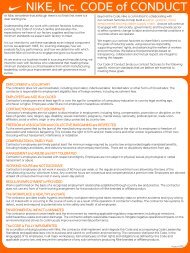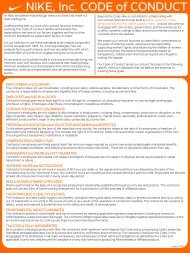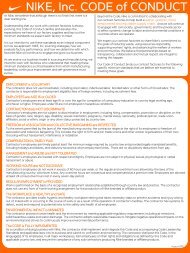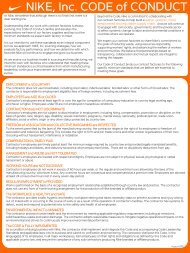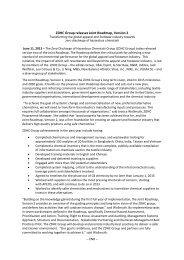COC CLS - Healthy Safety Environment - NIKE, Inc. - The Journey
COC CLS - Healthy Safety Environment - NIKE, Inc. - The Journey
COC CLS - Healthy Safety Environment - NIKE, Inc. - The Journey
You also want an ePaper? Increase the reach of your titles
YUMPU automatically turns print PDFs into web optimized ePapers that Google loves.
NANOMATERIAL MANAGEMENT<br />
STANDARD<br />
<strong>The</strong> contractor provides a safe, hygienic and healthy workplace setting and takes necessary steps to<br />
prevent accidents and injury arising out of, linked with or occurring in the course of work or as result of<br />
the operation of contractor’s facilities. <strong>The</strong> contractor has systems to detect, avoid and respond to<br />
potential risks to the safety and health of all employees.<br />
‣ Nike currently restricts the use of nanomaterials within apparel, footwear, and equipment<br />
product lines. Nanomateroials used by the contractor must meet the requirements noted<br />
within Nike’s Restricted Substance List (RSL) and Sustainable Chemistry guidelines.<br />
‣ Upon approval contractors must develop and implement a Nanomaterial program to protect<br />
employees and contractors from potential exposures related to the use, manufacture and<br />
disposal of nanoparticles, ultra fine particles, and nanoaerosols. Contractor must comply with<br />
requirements as outlined in this standard or relevant local laws and regulations, whichever is<br />
more stringent.<br />
RESPONSIBILITIES<br />
Location Manager must ensure that the nanomaterial program is developed, implemented and<br />
followed.<br />
HSE Representative must establish, maintain and administer the nanomatieral program. <strong>The</strong>y must (1)<br />
understand how nanotechnology may affect occupational health and (2) devise strategies for working<br />
safely with nanomaterials.<br />
Managers and Supervisors must ensure that employees are trained and adhere to the requirements of<br />
the nanomaterial management standard.<br />
Employees must adhere to the requirements of the nanomaterial management standard.<br />
DEFINITIONS<br />
• Nanoparticles are particles having a diameter between 1 and 100 nm. Nanoparticles may be<br />
suspended in a gas (as a nanoaerosol), suspended in a liquid (as a colloid or nano-hydrosol), or<br />
embedded in a matrix (as a nanocomposite).<br />
• Ultra fine particles is a term that has traditionally been used by the aerosol research and<br />
occupational and environmental health communities to describe airborne particles typically<br />
smaller than 100 nm in diameter.<br />
• Engineered nanoparticles are intentionally produced, whereas incidental nanoscale or ultra fine<br />
particles are byproducts of processes such as combustion and vaporization.<br />
• Nanoaerosol is a collection of nanoparticles suspended in a gas. <strong>The</strong> particles may be present as<br />
discrete nanoparticles, or as assemblies (aggregates or agglomerates) of nanoparticles.<br />
• Nanometer is one billionth of a meter.<br />
<strong>Safety</strong> <strong>CLS</strong> – Page 1<br />
04.14.10



